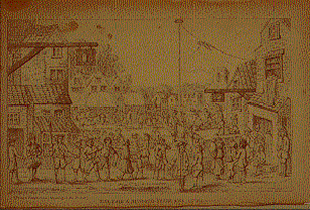May Fair

- May Fair in 1716
- Engraving after a watercolour in London Society. An Illustrated Magazine of Light and Amusing Literature for the Hours of Relaxation (London,1863) 4: 539
[click on the picture to enlarge it]
In 1688 King James II granted a royal charter to Sir John Coell and to his heirs entitling them to organise each year from the 1st to the 15th May a fair at Great Brookfield Street in the parish of Saint Martin in the Fields. May Fair, so called, in some ways replaced Saint James’s Fair which had been held on the same site since the reign of Charles 1st.
The entertainments offered during 15 days to the London public were more or less the same as those of Bartholomew Fair. Certain shows were particularly highly thought of. In 1701 all classes of society flocked to May Fair to applaud the famous rope dancer, Mrs Finley, alias Lady Mary, of the Barnes and Finley rope dancing troupe.
Despite its popular success, the fair was nearly abolished in 1702 following a police raid, during which a constable was killed. Mayfair had indeed become a place of some ill-repute, infested with pickpockets and ruffians looking for trouble, but its bad reputation did not put off the curious in search of strong emotions. In 1707, the actor William Penkethman produced a performing dog act announced sensationally in the Daily Courant of the 10th to the 13th May 1707 under the heading “Eight Dancing Dogs brought from Holland” which was an enormous success.
The year 1708 was marked by two events: the repurchase of the land on which May Fair was held by the architect Edward Shepherd (who gave his name to Shepherd’s Market built in 1735) and the royal proclamation of the 28 April 1708 banning the construction of fair booths “for Plays, Shows, Gaming, Musick-Meetings, or other disorderly Assemblies, [because] several Booths have been constantly built and made use of, during all the time of holding the said Fair, for entertaining Loose, Idle, Disorderly People with Plays, Interludes and Puppet-Shows.” The fair was not abolished, but the troupes of players were refused access. So, there were no theatre performances at May Fair until 1743, but other entertainments were offered to the public during this period. An engraving of the May Fair in 1716, depicts fencers, a violinist, the start of a donkey race and the May pole entwined with ribbons.
1743 saw the return of the theatre people to May Fair and in 1744, Hallam’s New Theatre was constructed near Shepherd’s Market House. An advertising bill, printed in the General Adviser of 1st May 1744, sang the praises of this “regular theatre [in which] Ladies and Gentlemen will be entertained in a more decent and commodious manner than they can possibly be at any booth.” The seat prices were the following : “stage 2s.6d./ boxes 1s. 6d./ pit 1s./ gallery 6d.” Farces, mime shows and comedies were performed throughout the duration of the fair and continued once the fair was over.
May Fair was soon the object of violent attacks by the Middlesex authorities. In 1745, a year of troubles at May Fair, the actors became the favourite target of the law and were labelled “rogues and vagabonds” responsible for quarrels, fights and even drunken brawls which happened regularly at the Fair. The site owner, Edward Shepherd, endeavoured to restore calm and to prove to members of the justice that order and decency prevailed at May Fair “as it remarkably has been every year since the present Proprietor has had the management thereof” (Daily Advertiser, 2 May 1745 ). The area had become developed as a series of fashionable squares and the residents complained about the fair.
In 1753, the duration of the Fair was reduced to 12 days (from the 1st to the 12th May). In April 1763, the inhabitants of Curzon Street and neighbouring streets signed a petition to demand the suppression of the fair and to put an end to its harmful effects. They did not win the case. When the Earl of Coventry came to settle in his new residence located not far from May Fair in 1764, he was very soon disturbed by the noise of the fair and used his influence to do away with the fair definitely.

